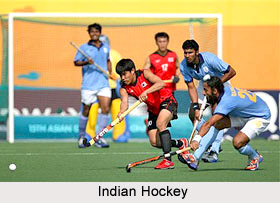 The game was originally played on grass in most parts of the world. However, the synthetic turf has become popular and is now the official surface in international hockey.
The game was originally played on grass in most parts of the world. However, the synthetic turf has become popular and is now the official surface in international hockey.
(a) Boundary lines - white
(b) Width of all lines - 3 in (8 cm) wide.
(c) Straight line drawn at 25 yd from each goal line.
(d) Goal placed in centre of goal line.
(e) The goal is made of two perpendicular posts, 4 yd (3.66 m) apart, joined together by horizontal crossbar 7 ft (2.13 m) from the ground.
(f) Width of goal post and crossbar - 2 in (5 cm) and not more than 3 in (8 cm) deep and the sides facing the field of play are rectangular.
(g) Coal Net - The net is attached at intervals of not more than 6 in (15 cm) to the goal posts, the crossbar and the ground behind the goal.
(h) The goals are completed by fixing three boards which are of 18 in (46 cm) height each inside the netting
Hockey Ball
Hockey ball is white in colour which weighs between 5 3/4 oz (163 gm) and 5 1/2 oz (155 gm) and has a circumference between 9 1/4 in (23 cm) and in (22 cm). Regulation ball is to be made of natural or artificial material, either white or painted white or as agreed and the inside core made of cork and twine.
Hockey Stick
There are no rules as to the length of the hockey stick but the weight must be between 12 and 28 oz (340-794 gm). The stick must be able to pass through a ring with a diameter of 2 in (5 cm) and have a flat face on its left side, rounded edges and wooded head.
Dress
Players wear shirts, shorts and socks with the colour of the team. In addition goalkeepers wear pads, kickers, masks and gauntlet gloves
Hockey Rules
Each player carries a "stick", normally a little over 3 feet (90 centimetres) long and traditionally made of wood but now often made with fibreglass, kevlar and carbon fibre composites, with a rounded handle flattening out on one side and with a hook at the bottom. New rules (2006) limit the curve of the stick so as to limit the power with which the ball can be flicked. The stick is only allowed to have a bow smaller than or equal to 25 mm, otherwise this is deemed to be illegal. The flat side of the hook is used to push, dribble, or hit a hard plastic ball. This ball is often covered with indentations to reduce hydroplaning that can cause an inconsistent ball speed on wet surfaces. Each field player normally wears a mouth guard and shin guards.
Although the only equipment required for goalkeepers (under FIH rules, local variants may require more) is a helmet and a stick, invariably they wear extensive protective equipment including chest guards, padded shorts, heavily padded hand protectors, leg guards, and foot guards (called "kickers"). Artificial turf or synthetic turf is a grass-like man-made surface manufactured from synthetic materials. It is most often used in arenas for sports that were originally or are normally played on grass; however, it is now being used on residential lawns and commercial applications, as well.








